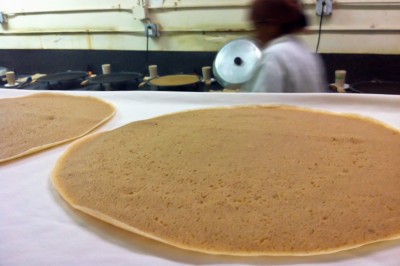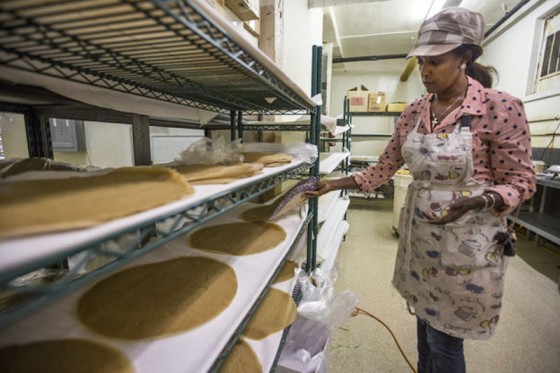Tasty, versatile and naturally gluten-free, injera is going mainstream. But the bakers at Amy’s Merkato are keeping their recipe close to the vest.
Bakers are good at keeping secrets. And Yodit Seyoum is no exception.
“Only me and my husband make the dough,” she told me over the phone when I asked her if I could tag along on a batch of what some call the best injera in Seattle.
Injera is a soft, sour flatbread made with an Ethiopian grain called teff and is eaten throughout East Africa as well as in Ethiopian, Eritrean and Somali restaurants and homes in the Pacific Northwest.
I first encountered injera as a teenager when I hung out with my Garfield High School buds at the cluster of Ethiopian restaurants on Cherry Street. These restaurants offered inexpensive platters of spicy stews piled on huge disks of bread — which served as both a platter and a utensil.
But I didn’t really get to know injera until I was on reporting trip to Ethiopia a few years back. There it was served as a staple at every meal and inspired a deep pride in the Ethiopians I met, many who peppered me with facts about its origins and nutritional merits.
Recent out-of-town guests, excited to sample what they described as “Seattle’s famous Ethiopian food,” got me wondering where the very best local injera might be found.
And that’s how I ended up in the back of Amy’s Merkato (a name inherited when Seyoum and her husband bought the Central District restaurant 13 years ago) staring into a 32-gallon vat of light-brown batter as the thick steam from hundreds of injeras rose around me.

“You never know how it’s going to turn out until you start baking it,” Seyoum says while packing the day’s orders into plastic bags stamped with a gold oval seal. “It depends sometimes on the weather … or when we make the dough.”
Teff is crucial to the taste of injera. A small, ancient grain native to the highlands of Ethiopia, it is high in iron, naturally gluten-free and very, very sour. Traditional injera is made exclusively with teff.
But Seyoum, who is originally from Ethiopia, says that American injera commonly contains additional flours such as wheat, corn or barley.
Like most breads, the trick isn’t in a complex list of ingredients, but in the subtle chemistry of ratios, timing and temperature.
The fermentation process of injera in those big vats is particularly important. It helps mellow the natural sourness of teff as well as create the signature, uniform holes that dot the bread.
In fact, it’s so important to the process that Seyoum is particularly cagey about sharing those details of her recipe. “I’d rather not talk about that,” she says with a sly smile when I ask, though she’ll admit that the dough ferments for two to three days on average.
Like any serious baker, Seyoum and her husband, Filli Abdulkadir, go to great lengths to protect the secrets of their trade. She says they haven’t taken a vacation together in years — in part because they wouldn’t trust their recipe with anyone else.
Whatever they’re doing, they’re doing it right. As cupfuls of the batter hit sizzling rows of electric griddles (overseen by relatives of Seyoum and Abdulkadir), Seyoum explains that the 5,000 injeras they produce per day are shipped around the Pacific Northwest and as far as Alaska and Colorado.
The rise in popularity of gluten-free diets has also raised injera’s profile. (Seyoum and Abdulkadir produce injera made only with teff for special orders).
Seyoum says she supplies a local caterer that makes spinach wraps out of injera. She’s also heard of injera being used to make Ethiopian “burritos” sold to young professionals in San Francisco, and that she’s even thinking of packaging individual injeras for sale in stores around Seattle.
But when she serves me, she says I should try it “the traditional way.” As I tear off a piece of fresh injera — a little crispy on the thin edge, the spongy middle soaked with flavor from a scoop of yellow lentils — I realize Seyoum has kept her secrets so close that I haven’t actually learned much about how this bread is made.
But by the time it’s in my mouth, I’m not sure I mind.



This place doesn’t answer the phone so I decided to make a long trip into Seattle to get some things for my husbands birthday. He loves Ethiopian cuisine. The place is closed down. Their website says nothing about being closed or moving to a new location. Why not let customers know? Not cool
We are very sorry for the inconvenience we cause you,we love to see you again,our new address is
5710 rainier ave s
Seattle WA 98118
2063242527
Thanks.